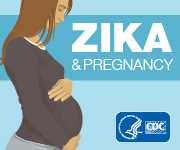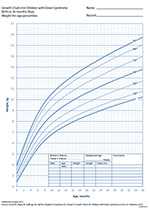Facts about Down Syndrome
Down syndrome is a condition in which a person has an extra chromosome. Chromosomes are small “packages” of genes in the body. Babies with Down syndrome have an extra copy of one of these chromosomes, chromosome 21.
Keaton's Story

Keaton was born with Down syndrome. Read his story as well as other stories from families affected by Down syndrome »
Growth Charts
What is Down Syndrome?
Down syndrome is a condition in which a person has an extra chromosome. Chromosomes are small “packages” of genes in the body. They determine how a baby’s body forms during pregnancy and how the baby’s body functions as it grows in the womb and after birth. Typically, a baby is born with 46 chromosomes. Babies with Down syndrome have an extra copy of one of these chromosomes, chromosome 21. A medical term for having an extra copy of a chromosome is ‘trisomy.’ Down syndrome is also referred to as Trisomy 21. This extra copy changes how the baby’s body and brain develop, which can cause both mental and physical challenges for the baby.
Even though people with Down syndrome might act and look similar, each person has different abilities. People with Down syndrome usually have an IQ (a measure of intelligence) in the mildly-to-moderately low range and are slower to speak than other children.
Some common physical features of Down syndrome include:
- A flattened face, especially the bridge of the nose
- Almond-shaped eyes that slant up
- A short neck
- Small ears
- A tongue that tends to stick out of the mouth
- Tiny white spots on the iris (colored part) of the eye
- Small hands and feet
- A single line across the palm of the hand (palmar crease)
- Small pinky fingers that sometimes curve toward the thumb
- Poor muscle tone or loose joints
- Shorter in height as children and adults
Types of Down Syndrome
There are three types of Down syndrome. People often can’t tell the difference between each type without looking at the chromosomes because the physical features and behaviors are similar.
- Trisomy 21: About 95% of people with Down syndrome have Trisomy 21.2 With this type of Down syndrome, each cell in the body has 3 separate copies of chromosome 21 instead of the usual 2 copies.
- Translocation Down syndrome: This type accounts for a small percentage of people with Down syndrome (about 3%).2 This occurs when an extra part or a whole extra chromosome 21 is present, but it is attached or “trans-located” to a different chromosome rather than being a separate chromosome 21.
- Mosaic Down syndrome: This type affects about 2% of the people with Down syndrome.2 Mosaic means mixture or combination. For children with mosaic Down syndrome, some of their cells have 3 copies of chromosome 21, but other cells have the typical two copies of chromosome 21. Children with mosaic Down syndrome may have the same features as other children with Down syndrome. However, they may have fewer features of the condition due to the presence of some (or many) cells with a typical number of chromosomes.
Other Problems
Many people with Down syndrome have the common facial features and no other major birth defects. However, some people with Down syndrome might have one or more major birth defects or other medical problems. Some of the more common health problems among children with Down syndrome are listed below.8
- Hearing loss (up to 75% of people with Down syndrome may be affected)
- Obstructive sleep apnea, which is a condition where the person’s breathing temporarily stops while asleep (between 50 -75%)
- Ear infections (between 50 -70%)
- Eye diseases (up to 60%), like cataracts and eye issues requiring glasses
- Heart defects present at birth (50%)
Other less common health problems among people with Down syndrome include:
- Intestinal blockage at birth requiring surgery
- Hip dislocation
- Thyroid disease
- Anemia (red blood cells can’t carry enough oxygen to the body) and iron deficiency (anemia where the red blood cells don’t have enough iron)
- Leukemia in infancy or early childhood
- Hirschsprung disease
Health care providers routinely monitor children with Down syndrome for these conditions. If they are diagnosed, treatment is offered.
Occurrence
Down syndrome remains the most common chromosomal condition diagnosed in the United States. Each year, about 6,000 babies born in the United States have Down syndrome. This means that Down syndrome occurs in about 1 out of every 700 babies.1
Causes and Risk Factors
The extra chromosome 21 leads to the physical features and developmental challenges that can occur among people with Down syndrome. Researchers know that Down syndrome is caused by an extra chromosome, but no one knows for sure why Down syndrome occurs or how many different factors play a role.
One factor that increases the risk for having a baby with Down syndrome is the mother’s age. Women who are 35 years or older when they become pregnant are more likely to have a pregnancy affected by Down syndrome than women who become pregnant at a younger age.3-5However, the majority of babies with Down syndrome are born to mothers less than 35 years old, because there are many more births among younger women.6,7
Diagnosis
There are two basic types of tests available to detect Down syndrome during pregnancy. Screening tests are one type and diagnostic tests are another type. A screening test can tell a woman and her healthcare provider whether her pregnancy has a lower or higher chance of having Down syndrome. So screening tests help decide whether a diagnostic test might be needed. Screening tests do not provide an absolute diagnosis, but they are safer for the mother and the baby. Diagnostic tests can typically detect whether or not a baby will have Down syndrome, but they can be more risky for the mother and baby. Neither screening nor diagnostic tests can predict the full impact of Down syndrome on a baby; no one can predict this.
Screening tests
Screening tests often include a combination of a blood test, which measures the amount of various substances in the mother’s blood (e.g., MS-AFP, Triple Screen, Quad-screen), and an ultrasound, which creates a picture of the baby. During an ultrasound, one of the things the technician looks at is the fluid behind the baby’s neck. Extra fluid in this region could indicate a genetic problem. These screening tests can help determine the baby’s risk of Down syndrome. Rarely, screening tests can give an abnormal result even when there is nothing wrong with the baby. Sometimes, the test results are normal and yet they miss a problem that does exist.
A new test available since 2010 for certain chromosome problems, including Down syndrome, screens the mother’s blood to detect small pieces of the developing baby’s DNA that are circulating in the mother’s blood. This test is recommended for women who are more likely to have a pregnancy affected by Down syndrome. The test is typically completed during the first trimester (first 3 months of pregnancy) and it is becoming more widely available.
Diagnostic Tests
Diagnostic tests are usually performed after a positive screening test in order to confirm a Down syndrome diagnosis. Types of diagnostic tests include:
- Chorionic villus sampling (CVS)—examines material from the placenta
- Amniocentesis—examines the amniotic fluid (the fluid from the sac surrounding the baby)
- Percutaneous umbilical blood sampling (PUBS)—examines blood from the umbilical cord
These tests look for changes in the chromosomes that would indicate a Down syndrome diagnosis.
Treatments
Down syndrome is a lifelong condition. Services early in life will often help babies and children with Down syndrome to improve their physical and intellectual abilities. Most of these services focus on helping children with Down syndrome develop to their full potential. These services include speech, occupational, and physical therapy, and they are typically offered through early intervention programs in each state. Children with Down syndrome may also need extra help or attention in school, although many children are included in regular classes.
Other Resources
The views of these organizations are their own and do not reflect the official position of CDC.
- Down Syndrome Research Foundation (DSRF)
DSRF initiates research studies to better understand the learning styles of those with Down syndrome. - Global Down Syndrome Foundation
This foundation is dedicated to significantly improving the lives of people with Down syndrome through research, medical care, education and advocacy. - Lettercase.org
This website houses a booklet entitled Understanding a Down Syndrome Diagnosis, which is available in print or digitally. - National Association for Down Syndrome
The National Association for Down Syndrome supports all persons with Down syndrome in achieving their full potential. They seek to help families, educate the public, address social issues and challenges, and facilitate active participation. - National Down Syndrome Congress
This website offers resources for families and professionals. The National Down Syndrome Congress seeks to educate, advocate, and empower. - National Down Syndrome Society (NDSS)
NDSS seeks to increase awareness and acceptance of those with Down syndrome.
References
- Parker SE, Mai CT, Canfield MA, et al. Updated national birth prevalence estimates for selected birth defects in the United States, 2004-2006. Birth Defects Res A Clin Mol Teratol. 2010;88:1008-16.
- Shin M, Siffel C, Correa A. Survival of children with mosaic Down syndrome. Am J Med Genet A. 2010;152A:800-1.
- Allen EG, Freeman SB, Druschel C, et al. Maternal age and risk for trisomy 21 assessed by the origin of chromosome nondisjunction: a report from the Atlanta and National Down Syndrome Projects. Hum Genet. 2009 Feb;125(1):41-52.
- Ghosh S, Feingold E, Dey SK. Etiology of Down syndrome: Evidence for consistent association among altered meiotic recombination, nondisjunction, and maternal age across populations. Am J Med Genet A. 2009 Jul;149A(7):1415-20.
- Sherman SL, Allen EG, Bean LH, Freeman SB. Epidemiology of Down syndrome. Ment Retard Dev Disabil Res Rev. 2007;13(3):221-7.
- Adams MM, Erickson JD, Layde PM, Oakley GP. Down’s syndrome. Recent trends in the United States. JAMA. 1981 Aug 14;246(7):758-60.
- Olsen CL, Cross PK, Gensburg LJ, Hughes JP. The effects of prenatal diagnosis, population ageing, and changing fertility rates on the live birth prevalence of Down syndrome in New York State, 1983-1992. Prenat Diagn. 1996 Nov;16(11):991-1002.
- Bull MJ, the Committee on Genetics. Health supervision for children with Down syndrome. Pediatrics. 2011;128:393-406.
- Page last reviewed: June 27, 2017
- Page last updated: March 3, 2016
- Content source:



 ShareCompartir
ShareCompartir
